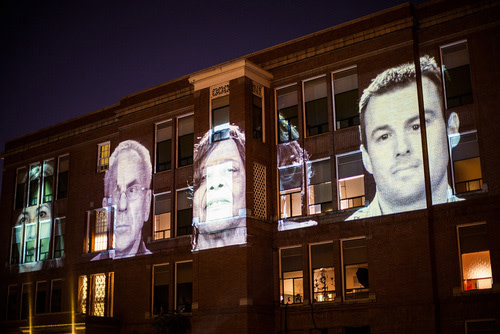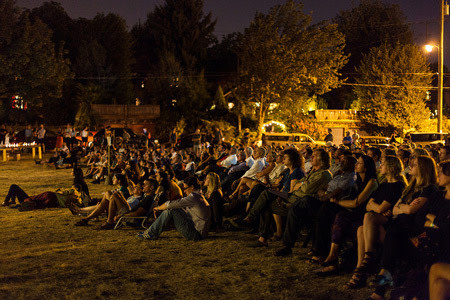TBA Day 2: Big Art Group's The People—Portland Review

The premise of the piece is intentionally unclear, but basically involves a reality television style director and crew who are intruding into a woman’s home and directing her into starring in their production of The Oresteia. They begin with a tour and then, putting a cardboard sign on her and holding cue cards in front of her, start directing her in the play, although she’s quickly replaced by one of the crew’s actresses when she’s not up to snuff. What’s never explained is why they’re there or why she’s going along with the production, particularly as the director gets more invasive and even sinister, at one point forcing her to murder him with her kitchen knife. Cofounders Caden Manson and Jemma Nelson told me this afternoon after their talk at PICA that it was inspired by true crime reality TV shows focused on the first 24 hours after a murder, but as the play touches on themes of terrorism, it’s hard to see the crew as anything but art terrorists invading someone else’s space.

The immediate magic of the piece is in the use of mostly lo-fi technology and props and the multi-level, spectacularly permeable use of Washington High School. The audience sits outside the high school and initially sees a live video feed of the woman inside the high school as she’s filmed by the crew’s cameras and projected via five different channels onto the outside walls of the high school. But then, as she gives the tour of her “house” (the school bathroom serves as her kitchen and classrooms as her living rooms), we see her and the crew through the windows of the building. Eventually the performers and crew end up outside filming right in front of us. Like much of Big Art Group’s work, the tension lies in choosing what to view: the making of the video, with all it’s raw imperfections; or the actual video, which turns lo-fi things like a giant silver mylar balloons or a small green screen into much fancier special effects on the screen (thus their moniker “Real Time Film”).
“We always get asked what am I supposed to look at, and that’s the question of the piece,” said Manson. “It reflects contemporary language about people living their lives and framing their lives at the same time—it reflects the way the audience is living now.”

Through the giant physical scale, as well as the eventually total shift from the amateur actress to the professional one (the transition is completed by layering their video feeds on top of each other and having the amateur lip synch to the professional), it also transforms our individual lives into something epic. As we progress into the story of The Oresteia (the whole time the director giving instructions, calling ‘cut,’ belittling the performances, and adding trashy flourishes), it starts to incorporate excerpts from interviews filmed with 36 Portlanders last May on the topics like justice, war, terrorism, democracy, as well as several other live amateur Portland performers (who are only given one run through) and professional actors from Big Art Group. Through both the director’s interview with the woman about what she watches on TV and then these topical interviews, it seeks the point that, much like The Oresteia’s House of Atreus, even those spaces we consider personal and private have public repercussions. We are not sealed off, and the personal is political.
A couple of technical glitches aside, the first half was totally captivating, as we’re dazzled by the almost alchemical transformation of lo-fi production (like ketchup squirted onto someone during their death scene) into something so technologically and conceptually rich. The first time local actors who are literally experiencing the full production for the first time in front of us bring us personally into the play, allowing for some profound moments as they/we encounter the story (“Do you know your neighbors?” asks the director. “Do you think you’re part of a community?”). The provocative themes are then counterbalanced by the director’s outlandish Ed Wood B-movie style of direction and the company’s use of mostly cast off items like a Burger King crown for props. (“In our work, we’re very interested in garbage, trash, and deciding what is trash,” Manson said during his talk at PICA. “It goes to how’s trash determined in our community—what ideas are garbage?”)
Towards the end, though, the performance for me simultaneously began to lose focus and to feel a bit heavy handed and preachy as we abandoned our original woman and the pretense of the TV crew and things turned entirely over to the professionals acting out The Oresteia, intermixed with the interviewees discussing democracy and the power of the vote. That said, I expected something even more heavy handed from the description (call me a populist cynic, but I don’t immediately bubble with joy at the thought of listening to a bunch of random strangers pontificating on democracy and justice). Instead, I left excited, thinking that the biggest surprise was the fact that TBA has gotten through nine years without presenting Big Art Group before.
The People: San Francisco from David Szlasa on Vimeo.
